Alaska: Inside Passage Cruise across Glacier Bay and Fjordlands of North America (Vancouver to Seward) & Drive Across the Denali (Seward to Fairbanks)
In July of 2013, we sailed the MS Statendam (Holland America Line) from Vancouver, Canada to Seward, Alaska, USA through the Inside Passage of the North American Fjordland and subsequently embarked on a road trip from Seward to Fairbanks. This is our story.
Here is the complete map of our sea and land route, with day trips and excursions.
Flight to Vancouver
June 28, 2013
We head out of Washington, DC for long flights to Vancouver.
Vancouver
June 29, 2013
Vancouver International Airport is a tastefully designed museum-like facility located on Sea Island in Richmond, British Columbia less than 10 miles southwest of downtown. The airport captures ancient history and rich cultural traditions of Indigenous peoples of Pacific Northwest who have been living around lower British Columbia since prehistoric times of c.10,000 BCE. The current city of Vancouver falls within traditional territory of three 6,000 year old Coast Salish peoples.
Sailing from Vancouver
Boarding the MS Statendam at Canada Place Cruise Ship Terminal
June 30, 2013 11:30 AM
Vancouver is comfortably among the most livable and beautiful cities of the world. Its Canada Place Cruise Ship Terminal is located on Burrard Inlet right next to downtown. The iconic complex is also Vancouver's primary trade and convention centre, having housed the Canada Pavilion at Expo 86 World Fair. Five 363 foot white teflon sails make it instantly identifiable.

We reach the port in the morning, board the Statendam and get mandatory safety training at our emergency evacuation point (Lifeboat #10). I forgot to set the daytime on the camera til later resulting in timestamps off by over a year in the first few photos.
We set sail at 11:30 AM. It is a distant 615 miles to our first destination port of Ketchikan, Alaska. We will spend two days on sea to dock there two mornings later.
Soon we are on our way from Burrard Inlet to Strait of Georgia out to the Inside Passage.
The MS Statendam
Holland America Line
Registered in Rotterdam and sailing under a Dutch flag, the 55,500 tonne Statendam was built by the Italian shipbuilding company Fincantieri S.p.A. in Trieste. It is powered by two 16,000 hp engines for a top speed of 22 knots (25 mph). It has 14 decks and can carry 1,258 passenger along with 557 crew members. MS Statendam is the flagship of Holland America Line's Statendam-class (S-Class) ships.
 |
| MS Statendam Deck Plan. Picture credit: Globus |
The ship is classy and very different from the few Afro-Caribbean Reggae infested pool-party and casino type Carribean cruise ships that we have previously sailed on. It exudes a sophisticated elegance with over $2 million worth of art and artifacts beautifully displayed throughout the ship. The Van Gogh Theater commemorating Dutch artist Vincent Van Gogh’s paintings The Starry Night and Irises is a work of art in itself. In the center of the ship a 3-story atrium showcases an elaborate 26-foot-high Fountain of the Siren sculpture. Sailing aboard the MS Statendam is world-class cruising at its finest (Ref: Globus). I walked around the decks and created this video slide-show:
We settle down in our home for the week and make ourselves comfortable.
Vancouver to Ketchikan
On Sea
July 1, 2013
11:00 AM
We are still in Canadian waters as the Statendam sails along Queen Charlotte Sound into Hecate Strait towards Ketchikan. An airplane-like screen in our cabin shows our location and progress along the cruise route.
It is foggy and not much was visible at breakfast a few hours earlier.
We will be sailing all day and night to reach Ketchikan early next morning. Relaxation aboard the ship is the order of the day. I find my favorite corner of the main deck and settle down. I would finish both books by the time we reach Seward.
20:02 PM
Dinner time. We are probably in the territorial waters of the United States by now. The fog has cleared and it is bright daylight. Indeed we do not expect it to get dark at all in the night from here on. Wild Alaskan Salmon is, of course, in order.

22:12 PM
With the sun hovering at its lowest point just over the horizon, dusk seamlessly merges into dawn. Regardless, we try to get some sleep.

Ketchikan
Rainfall Gauge, Totem Poles and Herring Cove
July 2, 2013
03:37 AM
We are somewhere around Hecate Strait getting close to Dixon Entrance. The ship's clock has fallen back one more hour to UTC-8 in American waters of the Alaska Bay. Whatever goes for dusk or dawn around midnight has changed to daylight in the land of the midnight sun. Our east-coast body clocks are so confused by now that caffeine seems to be in order at random times of the local day.
07:00 AM
We are pulling into one of the four cruise ship berths of the Port of Ketchikan. It is time to have breakfast and get ready for a long eventful day.

Ready for the day out, we disembark and walk into the pretty town of Ketchikan, Alaska.


Ketchikan is inhabited since at least c.9,000 BCE by Tlingít people ("people of the tides" - indigenous people of the Pacific Northwest Coast of North America) who call it "Kichx̱áan". In modern times it markets itself to its increasing tourist-oriented economy as the "Salmon Capital of the World" and "Alaska's First City". Ketchikan indeed is a leading global producer of canned and frozen Pacific salmon. The "first city" is a reference to Ketchikan being the first port of call in Alaska on the northbound Inside Passage sea route, including for cruise ship passengers like us. Another reason for the "first city" designation is that Ketchikan is now the oldest remaining incorporated city of Alaska after older cities and counties were consolidated into city-and-borough administrative units.
More interestingly, the town of Ketchikan has the largest number of indigenous totem poles in the world, some of which we will see a bit later.
An impressive sculpture called "The Rock" greets visitors coming in from docked cruise ships. It features a singing Tlingít woman and representative loggers and gold prospectors, with Tlingít chief Johnson standing next to them welcoming visitors.
There is a fair amount of late 1890s gold rush and copper mining in Ketchikan's recent history with some quantities of gold and copper still in production. However, the "Ketchikan Mining Co." located strategically in the corner right across cruise ships is actually a large souvenir and gifts shop sharing prime tourist visibility with a Harley Davidson dealership and branded clothing outlet.
Spruce Mill Way - the waterfront street next to the dock - is crammed with jewelers, cafes, seafood restaurants and souvenir shops.
We look at options for a Ketchikan city tour and day trip to Herring Cove. Strategically parked "Ketchikan Duck Tour" amphibious tour bus-boats are hard to miss, but their 90-minute tour only covers the town and totem poles.
We choose to go on the Ketchikan Trolley Wildlife, Totems & City Tour which covers the city, totem poles and Herring Cove. The tour vehicles are not really trolleys but buses inspired by San Francisco-style cable cars, including hard wooden seats that some may consider uncomfortable but add to the trolley vibe.
We drive around town taking in sights and history lesson from our guide. We see flowers at Whale Park, the old red-light district of Creek Street which is a wooden boardwalk with brothels on pilings on Ketchikan Creek and the Salmon Ladder on the Creek that was built long ago to help salmon up the difficult creek to their spawning grounds.
 |
| Whale Park, Ketchikan. Photo credit: Ketchikan Gateway Borough |
 |
| Creek Street: old red light district. Photo credit: Inn at Creek Street |
 |
| Salmon Ladder, Ketchikan Creek. Photo credit: Kai C./Foursquare |
Saxman: World's Largest Standing Totem Pole Collection
The ancient indigenous village of Saxman has the world's largest collection of standing totem poles. The most impressive totem collections are along Totem Row just under 3 miles south on Tongass Hwy from Ketchikan cruise ship dock.

Saxman (Tlingít: "T’èesh Ḵwáan Xagu") is an ancient indigenous village of just over 400 people. In addition to marveling at the remarkable totem poles, one can, for a fee, visit the inside of the Clan House and even participate in a native dance show there.
Watch: Saxman Village Dancers in the Clan House
Visitors can also watch artisans carve and paint wood in a shed using traditional techniques and tools. Masks, totems and artefacts are still made to order at Saxman. There are intriguing gift stores too.
 |
| Saxman Village Clan House. Photo credit: Holland America Line |
Herring Cove
Watch: Ketchikan, Alaska, Herring Cove 2014: salmon, bears and eagles
Driving just under 6 more miles southbound on the scenic Tongass Hwy which wraps around the bottom of Revillagigedo Island to the east shore going up north gets us to Herring Cove, an excellent place to watch a bit of Alaskan wildlife from.

Countless salmon come up to the cove for spawning, providing a feast for black bears and bald eagles.
There is a walkable access track down to the edge of the western (inland) side of the cove.

We are lucky to be here in the Mid-June through early-September window to see black bears, that too in low tide that is best for watching them execute their fishing skills.

We watch mamma and teddy black bear snapping up salmon in the distance ahead of the buildings. We also see Bald Eagles perched on trees around but missed out on watching them hunt before it was time to head back to Ketchikan.
Ketchikan Liquid Sunshine Rain Gauge
Back in town, we check out the strange much-photographed tourist hit of the Liquid Sunshine Gauge erected on the right wall of Ketchikan Visitors Bureau at Front St and Dock St across cruise ship dock Berth 2. Ketchikan is among the wettest places in the country. It gets at least 12.5 feet of rain every year (probably represented by the fish hanging off to the right) and this gauge is one of the ways the city tracks the amount of "liquid sunshine" it is proud to have received so far in the current year. It appears almost 17 feet of rain walloped Ketchikan in the year of 1949. The gauge also informs us that Ketchikan is the 4th largest city in Alaska along with other trivia.
Did I read the gauge correctly as saying just 2 feet of rain so far this year of 2013, though we are on the 2nd of July?
Ketchikan Post Office - Highest Zip Code in USA
Another curiosity of Ketchikan is that it is assigned the highest ZIP code of the United States 99950. Since there are no roads to Ketchikan, all mail and package delivery services have to rely on air and water routes to the outside world. I purchased picture postcards and mailed one back home from here as a souvenir.
9:00 PM
By dinner time, the Statendam has weighed anchor and resumed sailing the inside passage to our next port of call: 292 miles to Juneau.
We are sailing 292 miles under the midnight sun from Ketchikan to Juneau, administrative capital of the state of Alaska, on the Inside Passage. In a few more hours we will encounter the first of the great glaciers of the Juneau icefield. It is time to get some sleep the best we can.
09:00 AM
As we sail the Gastineau Channel towards Juneau port on a foggy rainy morning we see beautiful waterfalls from glacial outflows of the Juneau Icefield.
Since Juneau is the only state capital in the 49 states of continental United States (excluding the island state of Hawaii) that has no road to the outside world, residents have to rely on seaplanes and boats to get around. They love it this way, parking seaplanes and boats in their homes the same way we landlubbers park automobiles in our garages and driveways. In addition to formidable engineering challenges of building a road over a rugged topography of mountains, rivers and fjords, Juneau dwellers are not too keen on becoming highway-connected, either. The proposed Lynn Canal Highway to Skagway shows no sign of progress.
We spot a couple of seaplanes flying low in the sky.
We get closer to the port of the pretty city of Juneau nestling in the slopes of Mount Juneau in the Boundary Ranges. We spot the Bermuda registered Diamond Princess, and our sister ship of Holland America Line - the MS Oosterdam - already berthed at the cruise ship docks.
09:42 AM
With remarkable precision our ship parallel parks accurately aft-to-aft with the Oosterdam so closely that I can see right into the aft bedrooms of the Oosterdam! The technique is familiar to us road drivers - pull up about half way alongside the other ship, start turning in towards port till the fore is alongside the docking berth and finally bring in the aft to the berth. However, considering we are on a 56-tonne ship docking right behind a 82-tonne ship with literally a few feet between them, I was mesmerized watching the procedure. The following pictures are from aft of Deck 12 (Navigation Deck) of the Statendam.
Juneau, Tlingít: "Dzántik'i Héeni" - "Base of the Flounder's River," is the 2nd largest city of the United States by area. The top four largest cities of the country are all in Alaska due to consolidation of cities and counties in the state. It is also the only state capital of the United States that has an international border: it shares its eastern border with the territory of British Columbia, Canada.
As we disembark the Statendam, a fog-covered Mount Juneau and the surrounding mountains of the Boundary Range loom behind the Juneau Cruise Ship Port. The weather could have been better, but it still is very beautiful.
We have a "Juneau City with Mendenhall Glacier and Glacier Gardens" tour booked and find our coach waiting for us right next to the ship.
Aboard the coach, we first get a tour of downtown (map) including the historic Red Dog Saloon operating from gold rush era, Saint Nicholas Russian Orthodox Church dating from 1893 built with Russian panels, Alaska State Capitol and Alaska Governor's Mansion. Our guide narrates the interesting history of Juneau with trivia about prehistoric times to the late 1890s gold rush days and modern Juneau.
We then head out along the Gastineau Channel past the Mendenhall Tidelands surrounded by evergreen expanse of Tongass National Forest towards Mendenhall Glacier.
Mendenhall Glacier
11:32 AM
The Mendenhall Glacier Visitor Center sells books published by the Alaska Natural History Association (ANHA) - a nonprofit partner of Alaska’s parks, forests, refuges and other public lands.
The 15-mile long Mendenhall glacier is one of the over 40 glaciers flowing from the vast Juneau Icefield which covers southeast Alaska, USA through northwest British Columbia, Canada. It is among the most popular and spectacular glaciers in Alaska. Thunder Mountain, named after loud avalanches crashing down steep slopes, looms over Mendenhall Valley.
The glacial trough and lake of Mendenhall were likely excavated over the pleistocene (c. 2.6 million to 11,700 BCE). Despite upto 100 feet of annual snowfall on the icefield, Mendenhall and many of its glaciers have been retreating from around the mostly north-American "Little Ice Age" (c.1300-1850 CE).
Glacial ice, popularly called "Blue Ice", forms due to the sheer weight of ice at depths of about 200 feet. Glaciers also contain a historical record of the climate over their existence; annual snowfalls and variations in climate are recorded in its layers.
The easily accessible location of Mendenhall glacier east of Auke Bay just 12 miles north of downtown Juneau makes it a popular tourist destination. For numerous people including us, Mendenhall is an unforgettable first close and personal experience of a glacier.
The glacial Mendenhall Lake at the terminus of Mendenhall Glacier is a bedrock lake in the Mendenhall basin excavated by ancient moving ice flows. Large icebergs float around the lake which drains into the Mendenhall River that flows across the Mendenhall Valley into Fritz Cove on the Inside Passage (map).

To the right of the terminus (face) of Mendenhall glacier, there is a pretty two-stage 377-foot waterfall called Nugget Falls into a sandbar on Mendenhall Lake. We see a a large iceberg float on the lake between the glacier and the waterfall.

Nugget Falls is at the termination of Nugget Creek - an outflow of the Mendenhall tributary Nugget Glacier located at base of the adjacent Bullard Mountain.
In the past Mendenhall Glacier extended all the way across today's Mendenhall Lake. Nugget Creek dropped and flowed below the glacier with Nugget Falls cascading from the other side off the face of the glacier. People sometimes refer to this period as Mendenhall Glacier "covering" Nugget Falls.
A spectacular walk along Nugget Falls Trail (map) from behind the Visitor Center takes us to "Photo Point" that offers some of the best views of Mendenhall Glacier, Nugget Falls, Mendenhall Lake, the valley and the mountains around it.
We bid adieu to Mendenhall Glacier and Nugget Falls, find our tour bus and head to our next stop: Glacier Gardens.
Glacier Gardens Rainforest Adventure Tour
3:07 PM
Glacier Gardens in Juneau does not have anything to do with glaciers. It is a privately owned nursery and landscaping service that also offers a paid ride through their little part of Alaska's coastal temperate rainforest to the top of a hill on their property.

The property is beautifully conceived and maintained. The special "upside down trees" are uprooted trees with their stems chopped off and inserted into the ground so that the roots are now at the top. Carefully curated flowering plants now cover the upward-facing remnants of the original root balls. I especially liked the strategically placed flashes of blue.
The "Rainforest Adventure" consists of a drive in an open cart up to the top of a hill through lush vegetation of the North American coastal temperate rainforest - a tiny fraction of the 2,500 mile long rainforest which covers a coastal strip from northern California through Canada's British Columbia to the eastern edge of the Kodiak archipelago in southcentral Alaska. The forest primarily consists of ancient Western hemlock, Sitka spruce, Mountain hemlock and Alaska yellow cedar trees.
From the top of the hill, there is a great view of Juneau airport to Mendenhall wetlands with Mendenhall river meeting Fritz Cove in the distance.
The nursery store, a cafe and gift shop line the side of the central lobby which features cool hanging flowering plants from the top.
Glacier Gardens is a quiet peaceful place with well-arranged guided tour. We leave the property happy and our long day out at Juneau being over, we head back to the Juneau Cruise Ship Port and board the Statendam. Our next port of call Skagway is 202 miles away.
Skagway
July 4, 2013
04:00 AM
Happy birthday USA! The Statendam sailed from Juneau around dinner time. She is covering the 202 miles to Skagway. Around midnight we were sailing in daylight somewhere on the fjords of Favorite Channel heading towards Chilkoot inlet. By 4 AM, we are near Chilkoot inlet's fork into Lynn Canal.
Are we are looking at Davidson Glacier as we sail past the Haines Cruise Port and the town of Haines itself along the starboard?
It is around here that we see the Disney Wonder for the first time on our voyage. She will accompany us for a while.
The fjord keeps getting more beautiful as we sail further along the vast icefields. Snow-capped mountains, glaciers and waterfalls into the inlet become increasingly prevalent.
05:00 AM
We are sailing on the Lynn Canal entering the Taiya Inlet. Skagway is not far away now.
We are followed by the Wonder while getting closer to Skagway.
From the looks of it, I believe a Princess Lines cruise ship is also on the fjord ahead of us. Is that the Diamond Princess that we met in Juneau?
Skagway Cruise Port
06:00 AM
The beginning of Taiya Inlet marks the north end of Lynn Canal waterway from Juneau. At the north of Taiya Inlet, where the fjord ends, sits the town of Skagway - the northernmost port stop on our cruise route through the Inside Passage.
Settled from prehistoric times, Skagway (Tlingít "Skagua" - where the north wind blows) saw a sudden stampede of prospectors during the Klondike Gold Rush of late 1890's for a few years, who moved on to other parts of Alaska by the turn of the century as quickly as they came in. Around 100,000 gold diggers flooded the area between 1896 and 1899, triggering, among other things, the spectacular White Pass and Yukon Route railway which we ride here today.
The Golden Princess and a sister Princess Line ship are already docked at the Skagway Cruise Ship Port as we sail in.
The Disney Wonder sails in and docks next to us soon after our ship is berthed.
We disembark from the Statendam. The famous Face Mountain is visible behind the aft of the ship across the fjord.
We see the train track and a train waiting right across the bridge from the berth at which our ship is docked.
Legends of Face Mountain
Skagway, Alaska
Variations of an ancient Tlingít legend surround the howling winds and rough seas that Skagway and the Taiya Inlet are known for. The stories all involve a Tlingít woman named Kanagoo also known as Shakaԍéi (Skagway) - "Pretty Woman" - who transformed into stone and lies today as Kanagoo Yahaayí - Kanagoo's Soul - which we call Face Mountain.
One version has Kanagoo's two sons going out to the sea to never return. Kanagoo kept waiting and crying for so long that she turned to stone. She keeps wailing and crying for her sons that continue to cause high winds at Skagway. Another version of the legend replaces a lover for the sons.
 |
| Kanagoo / Shakaԍéi (Skagway) lying as the stone of Face Mountain |
White Pass & Yukon Route Railway
The Scenic Railway of the World
Watch: The White Pass and Yukon Route Railroad: breathtaking beauty of "The Scenic Railway of the World"
Skagway is a border town with its east end literally marking British Columbia province of Canada. Gold prospectors were required by Canada to carry a ton of food and supplies sufficient for independent survival for a year. The intent of the railway was to make hauling the huge quantity of supplies and animals of prospectors across rugged mountain and waterway trails easier. "The 33-mile-long Chilkoot Trail began at nearby Dyea; and the 40-mile White Pass Trail began at Skagway and paralleled the present-day route of the White Pass & Yukon Route railway (WP&YR). Thousands of men carried supplies up the Chilkoot Trail, which was too steep for horses, or took the 40-mile White Pass trail to Lake Bennett, where they built boats to float down the Yukon River to Dawson City and the gold fields, 500 miles distant. In 1898 a steam-operated aerial tramway was constructed on the steepest section of the Chilkoot Trail, which eased the burdens of those able to pay," according to An Explorers Guide to the North.
But by the time construction of the railway started in 1898, the gold rush was already winding down. The rail construction project subsequently saved Skagway from becoming a ghost town, employing a lot of locals to continue to transport people, freight and fuel to Whitehorse and mines in Yukon till the early 1980s. It was briefly shut down before reopening as a tourist attraction in the late 1980s, and now carries cruise ship passengers to the Canadian border and back through spectacular vistas that place it among the most scenic railroads in today's world.
The train literally starts right across the docking berth of our cruise ship.
With luxurious wood panelling and a iron fireplace going, the vintage rail car is unlike the passenger carriages we are used to in European high-speed trains, or for that matter, scenic railways that we have been on in eastern United States including Western Maryland Scenic Railroad, Walkersville Southern Railroad, Great Smoky Mountain Railroad, Tennessee Valley Railroad and others.
Soon our train pulls off following the narrow gauge railroad along Skagway river. It is initially lead by a historic steam engine, but two diesels will be added later to climb across the mountains.
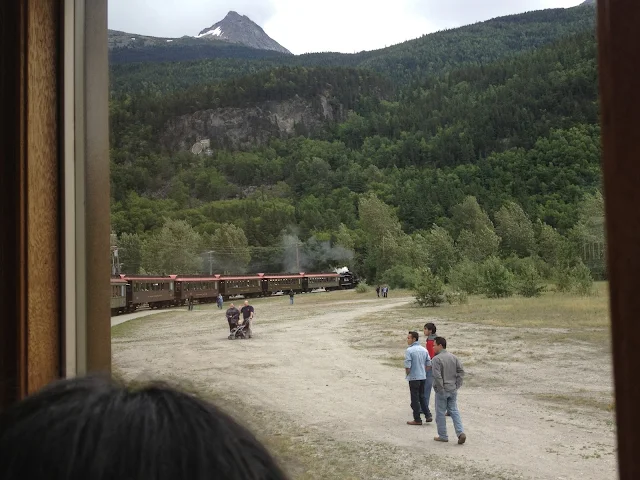
We see the Klondike Gold Fields that is now a tourist stop for visitors to learn gold panning first-hand and keep the gold they obtain. Visitors can also see dogs and dog-sleds. Mushers (dogsled drivers) explain everything about dog-sleds and racing the Iditarod Trail Sled Dog Race. In addition, there is an old gold dredge that still operates and a brewery.
Our train chugs along Skagway river on to Boulder.
We get some panoramic views of Denver Glacier and the glacial lake.
Denver Caboose Cabin at Denver Glacier Trailhead
We see the unique caboose that is available for renting from Tongass National Forest Service at Denver Glacier trailhead. "This unique cabin is a refurbished 1960s railroad caboose that is retired from the White Pass and Yukon Railroad. It is an ideal base for outdoor enthusiasts who want to hike to the Denver Glacier," say the National Forest Service.

We cross the track switches at South Clifton Switch and North Clifton Switch.
"On To Alaska With Buchanan"
8.8 miles from Skagway, we reach Clifton and see the Buchanan Rock with huge "On To Alaska With Buchanan" sign painted on the cliff. This historic curiosity refers to a Great Depression-era project of Detroit businessman George Buchanan of inspiring young boys and girls to be adventurous and self-sufficient by hiking across the vast mountains, gorges, glaciers and water bodies of Alaska while learning skills to earn money. "Mr. Buchanan and 50 or 60 boys journeyed across Canada to Vancouver, sailed up the coast to Skagway, spent several weeks touring Alaska, climbing glaciers, panning for gold. Part of the deal was that their parents would donate 1/3 of the money ($81), George would donate 1/3 of the money and the boy would work selling items such as kitchen implements door to door to raise the remaining 1/3," say Skagway Stories.

The building above the cliff is the US Customs and Border Protection, Skagway Port of Entry.
The train continues past Pitchfork Falls to Black Cross.
We continue across Bridal Veil falls, Glacier, Wood Trestle Bridge, Tunnel and Steel Cantilever Bridge.
Finally at just over 20 miles from Skagway, we approach White Pass at the USA-Canada border.
We see the historic cabin of the Canadian NWMP (North West Mounted Police). This was the control point for entry into Canada where Canadian customs officials made sure prospectors entering Canada had enough supplies and equipment to survive for a year. The NWMP were a precursor of the modern day RCMP (Royal Canadian Mounted Police).
White Pass just across the Canadian Border is as far as the current tourist train goes. We return to Skagway cruise ship port enjoying the spectacular vistas once again.
We set sail back out of the Taiya Inlet and Lynn Canal. We are headed to Glacier Bay accompanied by the Disney Wonder.
Glacier Bay
July 5, 2013
12:00 AM
After leaving Skagway, we are sailing south under the midnight sun on Lynn Canal and then west to Glacier bay. The density and intensity of blue snow-capped glaciated mountains jutting out of mirror-still blue water is on the rise.
Glacier Bay Basin
07:00 AM
We are sailing the Glacier Bay Basin towards Tarr Inlet. The Glacier Bay Basin is in the Glacier Bay National Park and Preserve which is part of a UNESCO World Biosphere Reserve that is the world's largest UNESCO protected biosphere. The Glacier Bay National Park and Preserve along with Canada's Wrangell-St. Elias National Park, Kluane National Park and Tatshenshini-Alsek Parks are a UNESCO World Heritage site.
Breathtaking panoramic views from the numerous fjords, inlets, channels, lagoons and islands of Glacier Bay transport us into a world far different from our east-coast urban jungle. The Disney Wonder is also sailing the same route.
Glacier Bay was one massive glacier in an enormous icefield around 1750. Increasing temperatures and decreasing snowfall have resulted in the modern 65-mile long main fjord with numerous channels, inlets, islands and smaller glaciers around it.
Johns Hopkins Glacier
09:45
Most of the over 1,000 glaciers in Glacier Bay are up in the mountains, but some tidewater and lake glaciers do flow down to the water. Just before Tarr Inlet, the Statendam turns left sailing west on Johns Hopkins Inlet. At the end of the fjord we come up close to our first tidewater glacier on the bay: the spectacular Johns Hopkins Glacier.
Numerous glaciers flow from mountain tops 12 and more miles behind the waterline, eventually merging into the Johns Hopkins glacier. As the Statendam sails up close to the spectacular mile-wide 300-foot high terminus, we see the many black bands of rock and silt debris contributed by the tributary glaciers as they cut through the mountains.
Johns Hopkins is not only vigorously active and advancing, it is the fastest flowing glacier of Glacier Bay. It was reportedly advancing 8 feet every day in the 1970s though it is slowing down now.
A significant part of the face of Johns Hopkins Glacier is underwater. There is also a substantial extension of the ice face at the deeper submerged part. Meltwater from underwater face and sides of the glacier form strong freshwater currents in the saltwater inlet, sometimes powerful enough to break through as water fountains. In addition, when large chunks of ice calve underwater, they pop up suddenly and violently as icebergs.
Gilman Glacier
Gilman Glacier is right next to Johns Hopkins Glacier. The two glaciers join up and separate intermittently over the course of time.
Gilman Glacier pretty much flows by itself without tributaries bringing in moraine. The lack of rocks, debris and silt makes Gilman look far cleaner than Johns Hopkins.
As we leave Johns Hopkins inlet to turn into Tarr Inlet, the gorgeous pair of Johns Hopkins and Gilman glaciers will remain etched in our minds as one of the most unforgettable sights of the Inside Passage.
Harbor Seals of Glacier Bay
Right around here, we see our first Harbour Seal. These seals are among the most common mammals found in the bay and often hang around cruise ships and follow smaller boats.
The Grand Pacific Glacier and Margerie Glaciers
10:00 AM
By 10 AM, we are well into Tarr inlet. The enormous dark face of Grand Pacific Glacier is straight ahead and Margerie Glacier is coming up on our left. We see a tiny bit of the vast icefield stretching to the horizon.
Margerie Glacier was once joined with Grand Pacific Glacier but the receding Grand Pacific Glacier resulted in separation in 1992.
Margerie Glacier originates 21 miles away in the Fairweather Range from the slopes of Mount Root. It is actively flowing in a stable state. Submerged meltwater currents in the salt water of the inlet sometimes push up parts of glacier or erupt as fountains on it.
Grand Pacific Glacier
The Grand Pacific is the greatest of glaciers that cut through mountains creating the Glacier Bay.
At its terminus at the head of Tarr Inlet, the two-mile wide and 210 feet high face (60 feet of which is under water) of the glacier is merely and indication of how grand it is. Behind the face, there lies as 35-mile long glacier that is upto 900 feet deep in glacial ice.
Grand Pacific Glacier originates across the international border at Mount Hay in the St. Elias Mountains of Canada (map). The dirty-looking left third of the face is contributed by its tributary Ferris Glacier.
Glaciers, Glaciers Everywhere ...
Lamplugh Glacier, Reid Glacier
We sail out of the Tarr Inlet back across the Glacier Bay Basin past Lamplugh Glacier and Reid Glacier skipping yet another fjord to the east of Tarr Inlet where Riggs Glacier and McBride Glacier come down to the water.
On Sea: Glacier Bay to Seward
July 6, 2013
8:00 AM
As the Statendam sails almost 700 miles across the Gulf of Alaska from Glacier Bay to Seward, we spend a relaxed day on sea.
8:00 PM
The last dinner on the ship is a somewhat formal affair. Regardless, our boy fell asleep at the dining table!
The sea voyage will soon come to its end.
End of Sea Voyage at Seward and Road Trip to Anchorage
July 7, 2013
6:00 AM
The MS Statendam docks at the Seward Cruise Ship Terminal early in the morning.
Seward has outsized importance for its small population of under 3,000 souls. It is named after William H. Seward, who was the Secretary of State at the time Russia sold Alaska to the United States in 1867. It is the southern end of the Alaska Railroad as well as Highway 9 (Seward Highway) which connects with Alaska Highway 1 to big city Anchorage (we will drive this route shortly). The southern end of the historic 1000-mile Seward to Nome Iditarod trail (also famous for the Iditarod Dog Sled Race) is marked by a Mile-0 post on the Seward shore.
Seward is also a major commercial fishing hub with tens of thousands of tons of fish brought in by fishing boats and processed here.
It is here at the Dale R. Lindsey Alaska Railroad Intermodal Facility ("cruise ship dock" to locals) that we bid farewell to the MS Statendam which has been our home on the sea for a week. She will be fondly remembered the rest of our lives. Collecting our luggage, we head out from the Cruise Ship Terminal and start the rest of our journey by road.
Interestingly, our boy seems to be the happiest getting off the ship.
Alaska Wildlife Conservation Center Animal Sanctuary
July 7, 2013
10:00 AM
Starting our road trip from the port of Seward, we get on Alaska State Highway 9 (Seward Highway) heading to the Alaska Wildlife Conservation Center nestling in the foothills of the majestic Portage Glacier. The drive through Portage Valley on this foggy day is still spectacular.
"The Alaska Wildlife Conservation Center is a non-profit organization dedicated to conservation, research, education, and animal care. The center is located on about 200 acres (81 ha) at the head of Turnagain Arm and the entrance to Portage Valley, Milepost 79 of the Seward Highway, about 11 mi southeast of Girdwood. The center is in the Municipality of Anchorage on the approximant border of the Kenai Peninsula and the Kenai Mountains to the south and the Chugach Mountains to the north. It is a Wildlife sanctuary for orphaned or injured wildlife, as well as home or temporary home to captive born and translocated wildlife such as wood bison. It is a wildlife sanctuary that provides comfortable, permanent homes for orphaned and injured animals." (Wikipedia)
There is a shuttle bus that takes us around the Conservation Center.
We see bald eagles on trees.
There is a bald eagle named Adonis whose left wing had to be completely amputated because of a bullet injury from someone illegally shooting at him.
 |
| Adonis the Bald Eagle with amputated wing |
Rescued Great Horned Owls (also called Tiger owls or Hoot owls) are up next, sleeping peacefully in the daylight.
We see a Northern Cat (Lynx) - the only cat native to Alaska.
There is great opportunity to watch rescued grizzly bears from up close. Mamma and baby bear are particularly delightful to watch. Each grizzly needs about 40 salmon every day in the summer months to survive the upcoming winter.
Deer, Moose, Elk, Bison and Muskox are abundant around the Conservation Center. We observe their caretakers feed some of them.
There is a boardwalk next to the main building that offers some spectacular views of the conservation center nestling in the glaciated mountains.

1:00 PM
We depart the Conservation Center by mid afternoon and head north towards Anchorage. It is an hour's drive to our hotel near Anchorage airport.
Anchorage
July 8, 2013
Flattop Mountain
10:00 AM
Chugach State Park is located just half an hour east of downtown Anchorage. On clear days, the trail head at Glen Alps provides nice panoramic views of Anchorage city and surrounding mountains and lakes. The 3-mile long Blueberry Loop Trail leading 1,500 feet up to the peak of Flattop Mountain has some stairs made from railroad ties and a rocky stretch towards the top that may need hikers to crawl on all four. Regardless, Flattop Mountain is the most-climbed mountain in Alaska.
Point Woronzof Park is famous as a viewpoint for the Denali and northern lights in the winter. "The Tony Knowles Coastal Trail runs through it and the area has spectacular views of the inlet and surrounding mountain ranges. You can spot whales in the inlet and watch the jets land and take off from the Ted Stevens International Airport." (alaska.org)
Again, we lucked out on visibility due to clouds and fog.
DENALI
July 9 - 10, 2013
With six million acres of wilderness (of which glaciers cover one million acres), taiga vegetation giving way to tundra and Mt. Denali which the locals simply call "The Mountain" towering 20,310 feet up in the snow-covered ranges with wildlife roaming free in a vast timeless mountainscape of peace and solitude, Denali is a life changing experience.
Visitors look out for the the "big five" of Denali in their natural habitat: moose, caribou, sheep, wolves and grizzly bears. As for humans, the vast lands of Denali has been home to native Alaskans for thousands of years.
One cannot drive the only narrow road that goes east-west across most of the park. There are tour buses that visitors have to choose from with various options from free to paid guided tours.
A great place to have lunch is the Prospector's Pizzeria and Alehouse at Mile 238.5 on the Parks Hwy.
Denali Highway and Fairbanks
July 10, 2013
From Denali National Park, we drove a bit on the Denali Highway (Alaska Highway 8) which regularly tops lists of most scenic roads of the world before turning around and heading to Fairbanks where we overnighted at a cute B&B before flying home.
Denali Highway
The End.






















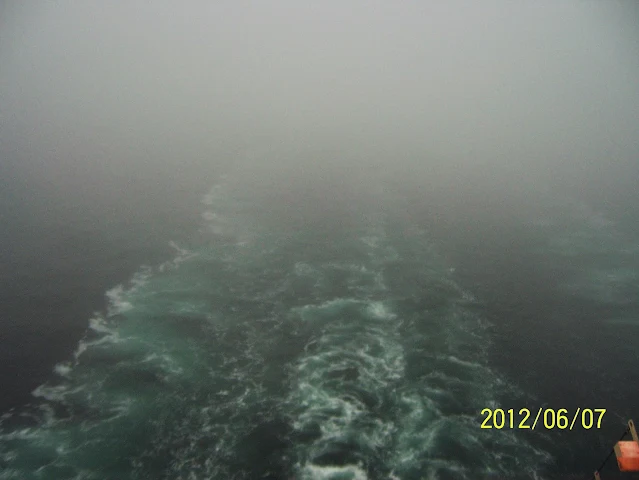























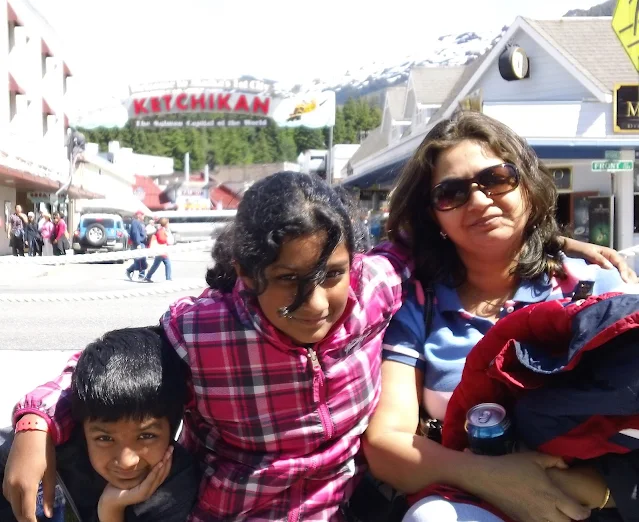


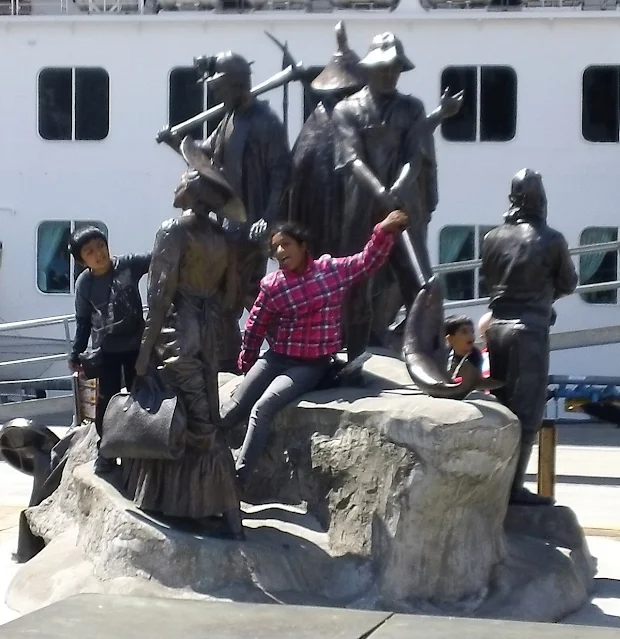




























































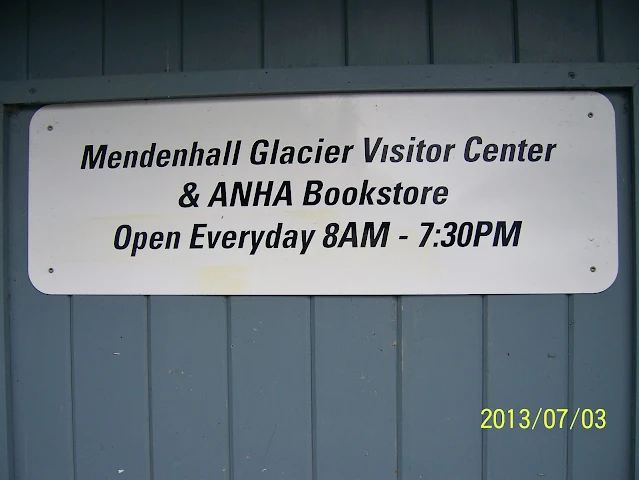

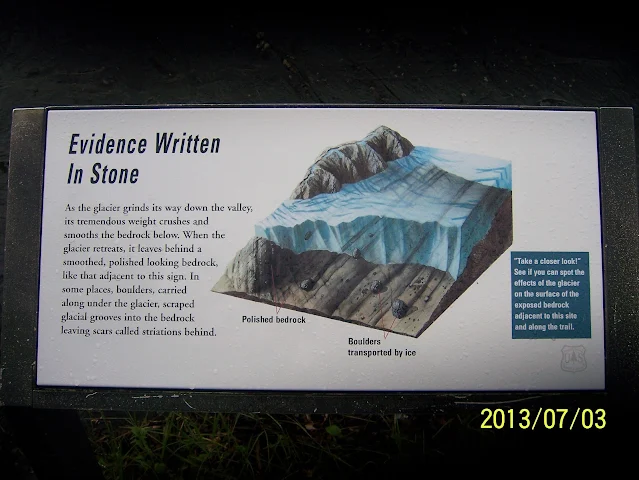






























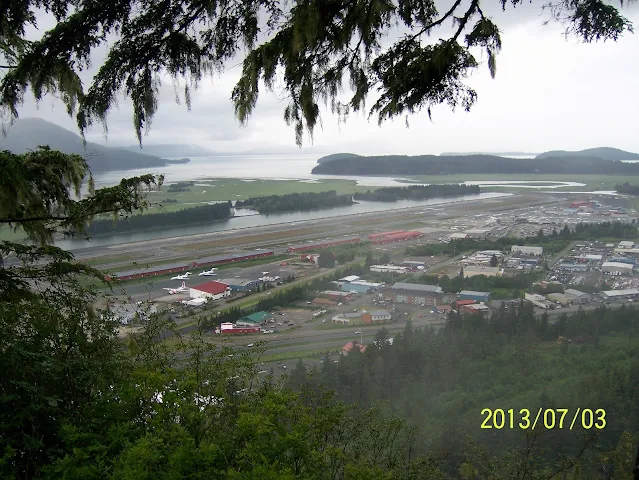





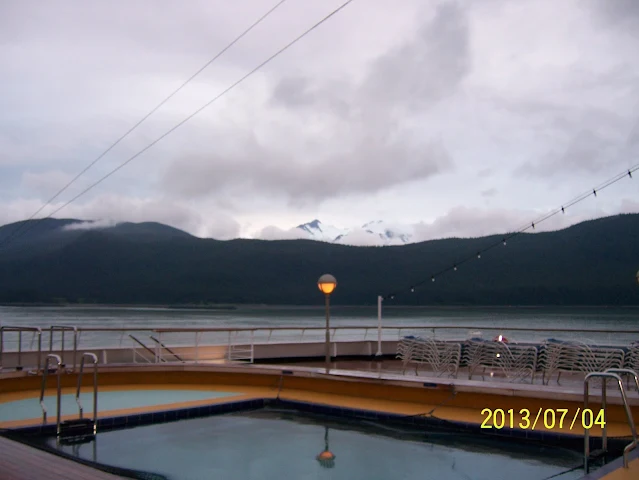





































































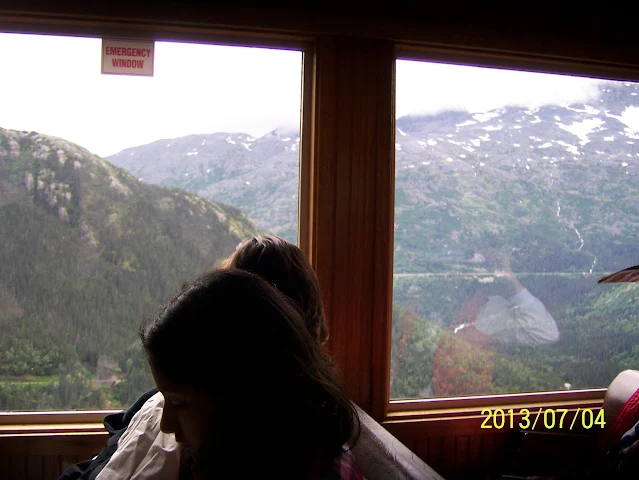






































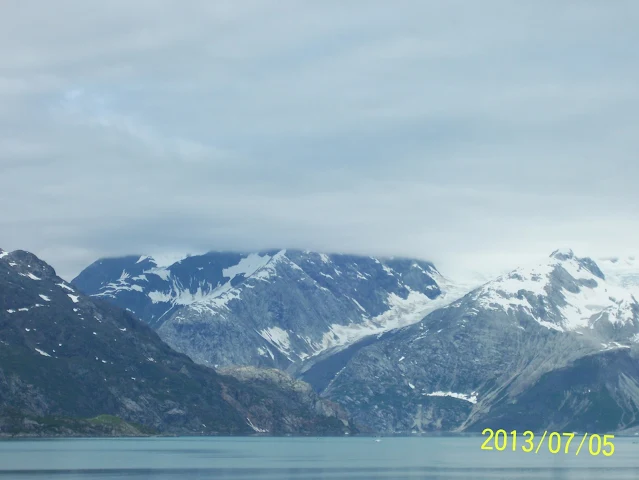



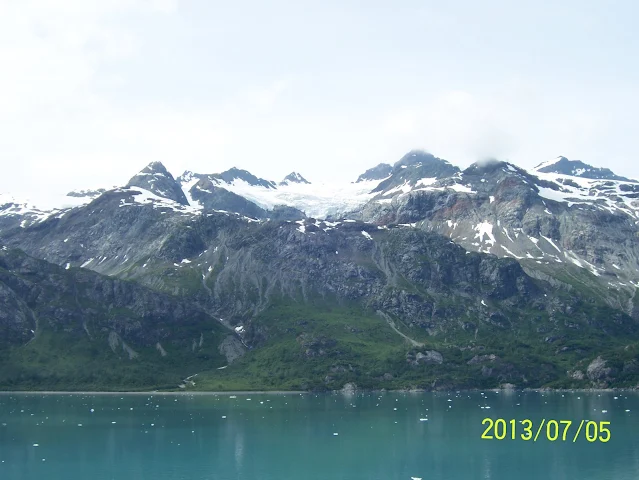





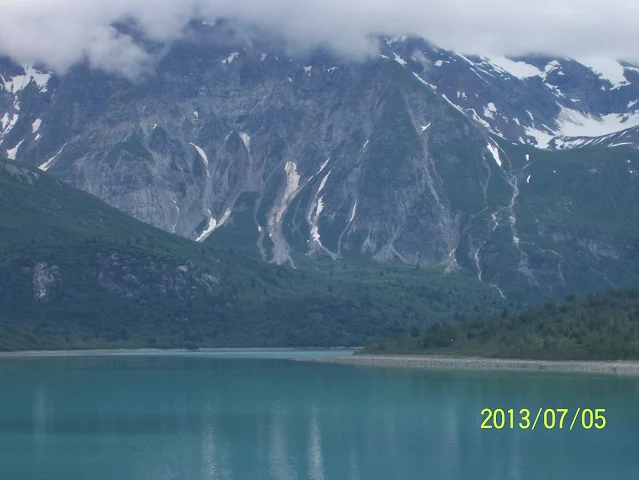



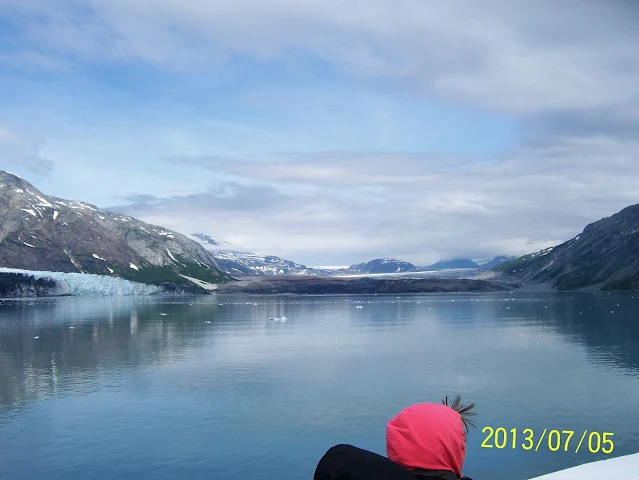














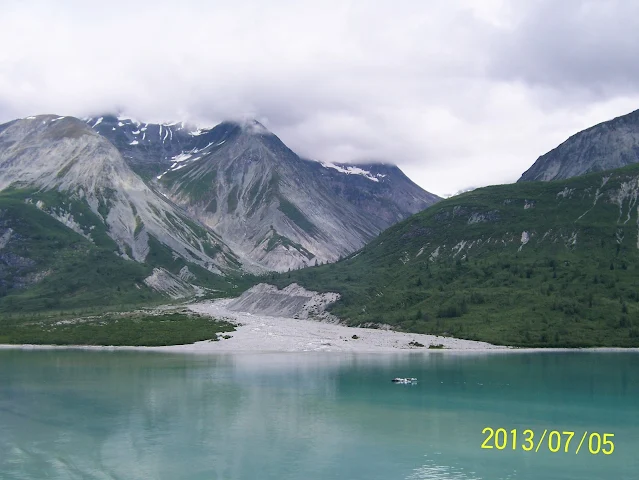




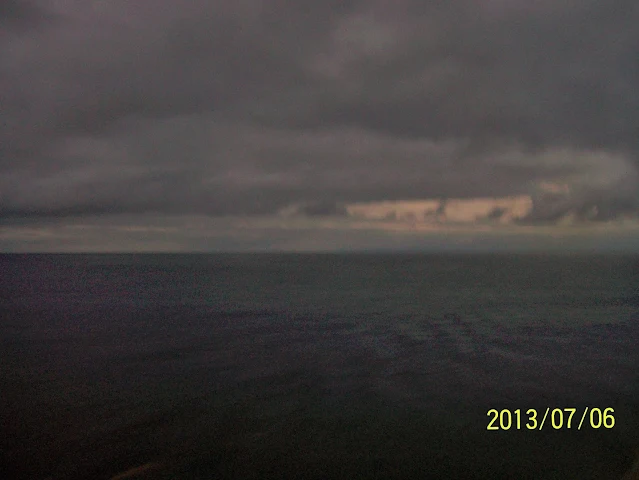















































































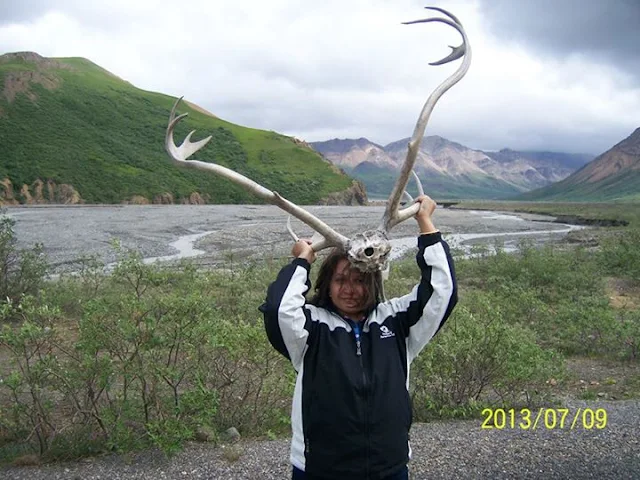







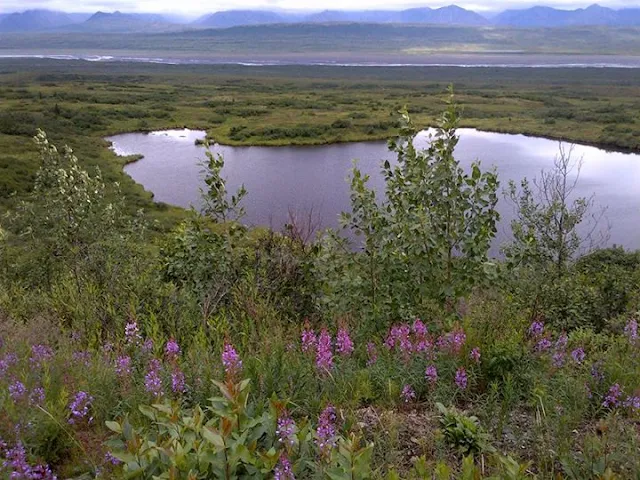





















0 comments